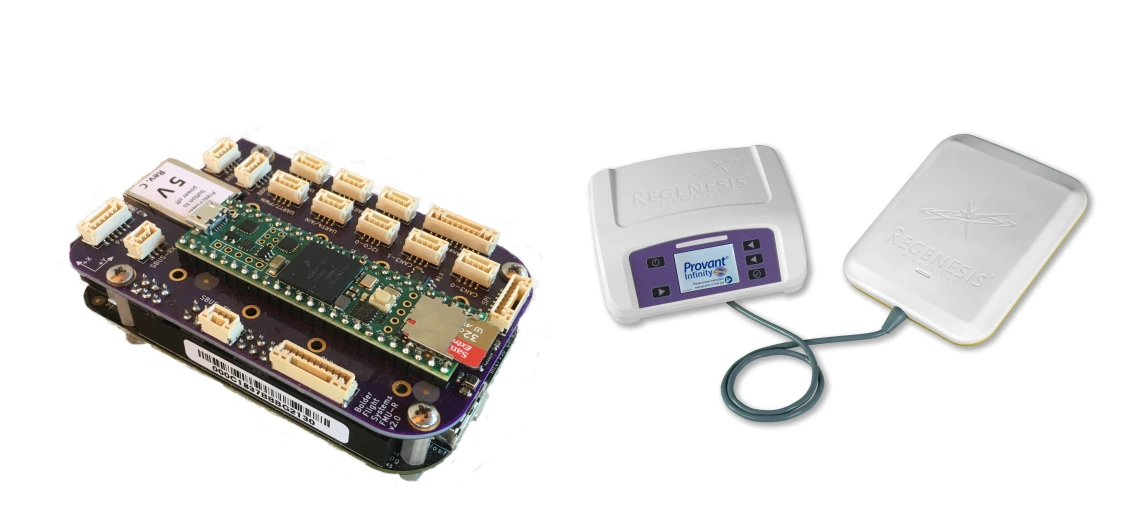New Sponsors Look Toward Long-Term Benefits

Bolder Flight Systems and Regenesis Biomedical are two of this year's new sponsors.
The support of industry partners is critical to the Interdisciplinary Capstone Program, which provides seniors with hands-on, real-world experience to carry them into their careers. The 2021-2022 program is pleased to welcome several new sponsors, among them Bolder Flight and Regenesis Biomedical.
Bolder Flight Systems
For his own undergraduate capstone project, Brian Taylor, the CEO and co-founder of Bolder Flight Systems, designed an uncrewed aerial vehicle for Sierra Nevada Corp.
“It gave you a real-world design problem with a real customer, and it was a good flavor of what industry was like,” he said.
When he heard about the opportunity to sponsor a project for the UA Interdisciplinary Capstone Program, he jumped at the chance. Bolder Flight Systems, led by former NASA and Department of Defense researchers and flight test engineers, creates flight control and data acquisition systems. The systems are primarily for researchers using drones to conduct aeronautics research. The company is working to make low-cost, high-reliability technology more accessible to researchers, students and small businesses.
The project the company is sponsoring has to do with electronic speed controllers for drone motors. These controllers typically are powered by commands in a highly specific format. The senior design team is responsible for building a prototype of a new electronic speed controller that can communicate via a Controller Area Network (CAN bus). CAN bus is a standard for internal communications networks used in cars.
“We’re wanting to use CAN bus because it’s a really reliable standard in the automotive world,” Taylor said. “It will fit well within the ecosystem of a higher-reliability flight control system.”
By creating a device that integrates into existing networks, as well as uses common programming languages, Taylor hopes the students will serve the company mission of making these technologies more accessible.
In a sense, they’re also making the company more directly accessible to students, and Taylor says the company looks forward to building a partnership with UA.
“I kind of see it as a way of not only giving the students a good capstone but building that relationship with the university,” he said. These students are people we might see at conferences, or who might be potential employees. So, this is just the beginning of these longer relationships.”
Regenesis Biomedical
Among the products produced by Regenesis Biomedical, based in Scottsdale, Arizona, is a device that uses electromagnetic pulses to provide a non-invasive, non-opioid approach to pain management. When company representatives heard about the program through Dr. Marvin Slepian, a UA biomedical engineering professor and MD who serves on Regenesis’ medical and scientific advisory boards, it didn’t take them long to come up with a student project.
The pain management device consists of a base unit connected to a therapy applicator pad, which patients apply to the area where they are experiencing pain. However, the electromagnetic pulses they receive don’t cause any sensation, so patients sometimes can’t tell whether they are receiving the treatment. Furthermore, though the device itself tracks how much energy is being emitted, it can’t track whether the patient is receiving it. This means it’s possible a patient could turn on a treatment but have it placed incorrectly, or get busy with something else and walk away.
“What we thought of was a wearable device that could indicate to the patient that the treatment is working, but also track whether they’re treating – and potentially other biometrics too,” said Erica Tassone, the company’s director of life sciences. “It would basically be something they could wear, and when they’re treating, they could visually see it light up or something when it’s on.”
Tracking treatment and biometrics will also help gather evidence about how well the product is helping patients.
The company looks forward to connecting more with the University of Arizona and helping students grow. Vice president of engineering Manuel Ferrer-Herrera said he’s interviewed many students over the years, and those who have hands-on engineering and problem-solving experience always stand out.
“For me, working with students and interns is very special, because I was an intern many years ago, and someone believed in me,” he said. “I was very shy, and I didn’t have the right words to explain what I could offer, but someone believed in me, and gave me the opportunity, and that one opportunity turned into other opportunities and allowed me to grow.”

